Investigation of the Upper Safety Operating Pressure Limit for Underground Gas Storage Using the Fault Activation Pressure Evaluation Method
Abstract
:1. Introduction
2. Geological and Fault Characteristics
2.1. Geological Overview
2.2. Fault Characteristics
2.2.1. Geometric Features
2.2.2. Characterization Data of the Friction Coefficient of Fault Rock
2.3. Determination of the In-Situ Stress
3. Materials and Methods
3.1. Method for Evaluating Activation Pressure in Boundary Faults
3.2. Evaluation Method for Heterogeneity of Friction Coefficient on Fault Surfaces
3.3. Evaluation Method of Cap Rock Fracture Pressure
4. Results and Discussion
4.1. Activation Pressure of Boundary Faults
4.2. Calculating the Upper Limit of Hydraulic Fracturing Pressure for Gas Storage Cap Layers
4.3. Calculating the Upper Limit of Safe Operating Pressure for Gas Storage Facilities
4.4. Discussion
5. Conclusions
Author Contributions
Funding
Data Availability Statement
Acknowledgments
Conflicts of Interest
References
- Xu, C.; Xie, Z.; Kang, Y.; Yu, G.; You, Z.; You, L.; Zhang, J.; Yan, X. A novel material evaluation method for lost circulation control and formation damage prevention in deep fractured tight reservoir. Energy 2020, 210, 118574. [Google Scholar] [CrossRef]
- Li, S.; Fan, Y.; Guo, Y.; Wang, Y.; He, T.; Zhang, H.; Ye, J.; Chen, W.; Zhang, X. Simulation and control strategies for longitudinal propagation of acid fracture in a low-permeability reservoir containing bottom water. Processes 2024, 12, 792. [Google Scholar] [CrossRef]
- Khurshid, I.; Afgan, I. Geochemical investigation of CO2 injection in oil and gas reservoirs of middle east to estimate the formation damage and related oil recovery. Energies 2021, 14, 7676. [Google Scholar] [CrossRef]
- Inaolaji, A.; Wu, X.; Roychowdhury, R.; Smith, R. Optimal allocation of battery energy storage systems for peak shaving and reliability enhancement in distribution systems. J. Energy Storage 2024, 95, 112305. [Google Scholar] [CrossRef]
- Xu, C.Y.; Xie, J.; Kang, Y.L.; Liu, L.; Guo, K.; Xue, D.; You, Z.J. Fracture pre-propping and temporary plugging for formation damage control in deep naturally fractured tight reservoirs. SPE J. 2024, 27, 1–16. [Google Scholar] [CrossRef]
- Mahjour, S.K.; Faroughi, S.A. Risks and uncertainties in carbon capture, transport, and storage projects: A comprehensive review. Gas Sci. Eng. 2023, 119, 205117. [Google Scholar] [CrossRef]
- Xu, W.; Zhao, P.; Gou, F.; Wu, W.; Liu, A.; Wang, J. A combined heating and power system based on compressed carbon dioxide energy storage with carbon capture: Exploring the technical potential. Energy Convers. Manag. 2022, 260, 115610. [Google Scholar] [CrossRef]
- Mortezaei, K.; Amirlatifi, A.; Ghazanfari, E.; Vahedifard, F. Potential CO2 leakage from geological storage sites: Advances and challenges. Environ. Geotech. 2021, 8, 3–27. [Google Scholar] [CrossRef]
- Eigbe, P.A.; Ajayi, O.O.; Olakoyejo, O.T.; Fadipe, O.L.; Efe, S.; Adelaja, A.O. A general review of CO2 sequestration in underground geological formations and assessment of depleted hydrocarbon reservoirs in the Niger Delta. Appl. Energy 2023, 350, 121723. [Google Scholar] [CrossRef]
- Morris, A.; Ferrill, D.A.; Henderson, D.B. Slip-tendency analysis and fault reactivation. Geology 1996, 24, 275–278. [Google Scholar] [CrossRef]
- Ferrill, D.A. Stressed rock strains groundwater at Yucca Mountain, Nevada. GSA Today 1999, 9, 1–8. [Google Scholar]
- Castillo, D.A.; Bishop, D.J.; Donaldson, I.; Kuek, D.; De Ruig, M.; Trupp, M.; Shuster, M.W. Trap integrity in the Lam in Aria High-Nancar trough region, Timor Sea: Prediction of fault seal failure using well-constrained stress tensors and fault surfaces interpreted from 3D seismic. APPEA J. 2000, 40, 151–173. [Google Scholar] [CrossRef]
- Wiprut, D.; Zoback, M.D. Fault reactivation, leakage potential, and hydrocarbon column heights in the northern North Sea. In Norwegian Petroleum Society Special Publications; Elsevier: Amsterdam, The Netherlands, 2002; Volume 11, pp. 203–219. [Google Scholar]
- Gholami, R.; Raza, A.; Iglauer, S. Leakage risk assessment of a CO2 storage site: A review. Earth-Sci. Rev. 2021, 223, 103849. [Google Scholar] [CrossRef]
- Tenthorey, E.; Dance, T.; Cinar, Y.; Ennis-King, J.; Strand, J. Fault modelling and geomechanical integrity associated with the CO2CRC Otway 2C injection experiment. Int. J. Greenh. Gas Control 2014, 30, 72–85. [Google Scholar] [CrossRef]
- Meng, L.; Fu, X.; Lv, Y.; Li, X.; Cheng, Y.; Li, T.Y. Risking fault reactivation induced by gas injection into depleted reservoirs based on the heterogeneity of geomechanical properties of fault zones. Pet. Geosci. 2016, 23, 29–38. [Google Scholar] [CrossRef]
- Taghipour, M.; Ghafoori, M.; Lashkaripour, G.R.; Hafezi Moghaddas, N.; Molaghab, A. Estimation of the current stress field and fault reactivation analysis in the Asmari reservoir, SW Iran. Pet. Sci. 2019, 16, 513–526. [Google Scholar] [CrossRef]
- Roberts, S.J.; Nunn, J.A. Episodic fluid expulsion from geopressured sediments. Mar. Pet. Geol. 1995, 12, 195–204. [Google Scholar] [CrossRef]
- Ungerer, P.; Burrus, J.; Doligez, B.P.; Chenet, P.Y.; Bessis, F. Basin evaluation by integrated two-dimensional modeling of heat transfer, fluid flow, hydrocarbon generation, and migration. AAPG Bull. 1990, 74, 309–335. [Google Scholar]
- Jin, Y.J.; Fan, C.; Fu, X.; Meng, L.; Liu, B.; Jia, R.; Cao, S.; Du, R.; Li, H.; Tan, J. Risk analysis of natural hydraulic fracturing in an overpressured basin with mud diapirs: A case study from the Yinggehai Basin, South China sea. J. Pet. Sci. Eng. 2021, 196, 107621. [Google Scholar] [CrossRef]
- Kearney, L.M.; MacMinn, C.W.; Katz, R.F.; Kirkham, C.; Cartwright, J. Episodic, compression-driven fluid venting in layered sedimentary basins. Proc. R. Soc. A 2023, 479, 20220654. [Google Scholar] [CrossRef]
- Hu, T.; Pang, X.; Jiang, F.; Wang, Q.; Liu, X.; Wang, Z.; Jiang, S.; Wu, G.; Li, C.; Xu, T.; et al. Movable oil content evaluation of lacustrine organic-rich shales: Methods and a novel quantitative evaluation model. Earth-Sci. Rev. 2021, 214, 103545. [Google Scholar] [CrossRef]
- Zhou, L.; Zheng, X.; Lu, Y.; Li, H.; Feng, M. Fracture pattern and caprock integrity analyses via hydraulic fracturing for CO2 enhanced coal bed methane. Eng. Fract. Mech. 2020, 228, 106894. [Google Scholar] [CrossRef]
- Li, S.; Fan, Y.; Wang, Y.; Zhao, Y.; Lv, Z.; Ji, Z.; Chen, W.; Min, J. True triaxial physics simulations and process tests of hydraulic fracturing in the Da’anzhai section of the Sichuan Basin tight oil reservoir. Front. Energy Res. 2023, 11, 1267782. [Google Scholar] [CrossRef]
- Chang, X.; Xu, E.; Guo, Y.; Yang, C.; Hu, Z.; Guo, W. Experimental study of hydraulic fracture initiation and propagation in deep shale with different injection methods. J. Pet. Sci. Eng. 2022, 216, 110834. [Google Scholar] [CrossRef]
- Dahrabou, A.; Valley, B.; Meier, P.; Brunner, P.; Alcolea, A. A systematic methodology to calibrate wellbore failure models, estimate the in-situ stress tensor and evaluate wellbore cross-sectional geometry. Int. J. Rock Mech. Min. Sci. 2022, 149, 104935. [Google Scholar] [CrossRef]
- Shimamoto, T.; Logan, J.M. Effects of simulated clay gouges on the sliding behavior of Tennessee sandstone. Tectonophysics 1981, 75, 243–255. [Google Scholar] [CrossRef]
- Logan, J.M.; Rauenzahn, K.A. Frictional dependence of gouge mixtures of quartz and montmorillonite on velocity, composition and fabric. Tectonophysics 1987, 144, 87–108. [Google Scholar] [CrossRef]
- Saffer, D.M.; Marone, C. Comparison of smectite-and illite-rich gouge frictional properties: Application to the updip limit of the seismogenic zone along subduction megathrusts. Earth Planet. Sci. Lett. 2003, 215, 219–235. [Google Scholar] [CrossRef]
- Tembe, S.; Lockner, D.A.; Wong, T.F. Effect of clay content and mineralogy on frictional sliding behavior of simulated gouges: Binary and ternary mixtures of quartz, illite, and montmorillonite. J. Geophys. Res. Solid Earth 2010, 115, B03416. [Google Scholar] [CrossRef]
- Eijsink, A.M.; Kirkpatrick, J.D.; Renard, F.; Ikari, M.J. Fault surface morphology as an indicator for earthquake nucleation potential. Geology 2022, 50, 1356–1360. [Google Scholar] [CrossRef]
- Abdelaziz, A.; Ha, J.; Li, M.; Magsipoc, E.; Sun, L.; Grasselli, G. Understanding hydraulic fracture mechanisms: From the laboratory to numerical modelling. Adv. Geo-Energy Res. 2023, 7, 66–68. [Google Scholar] [CrossRef]
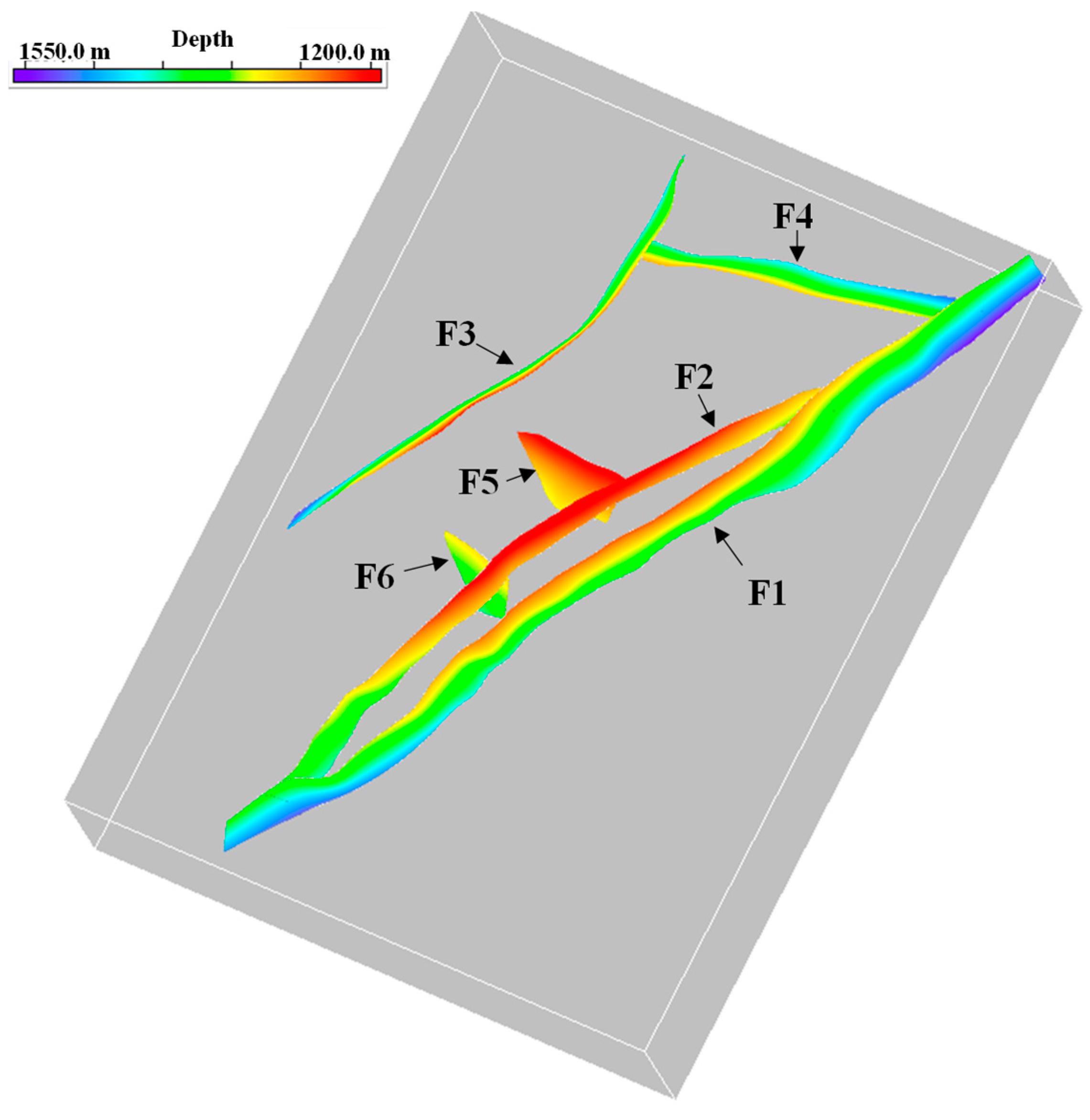
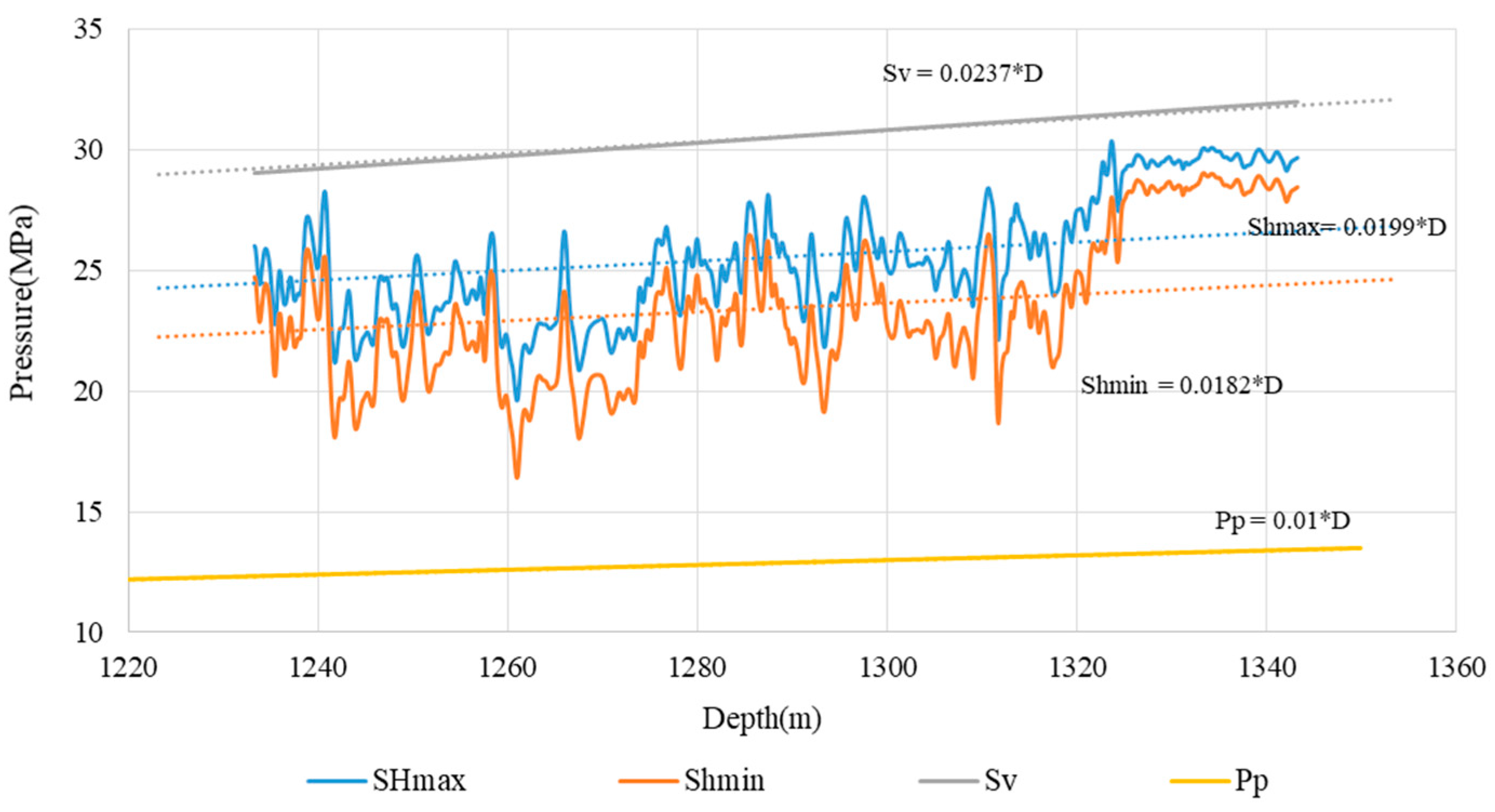
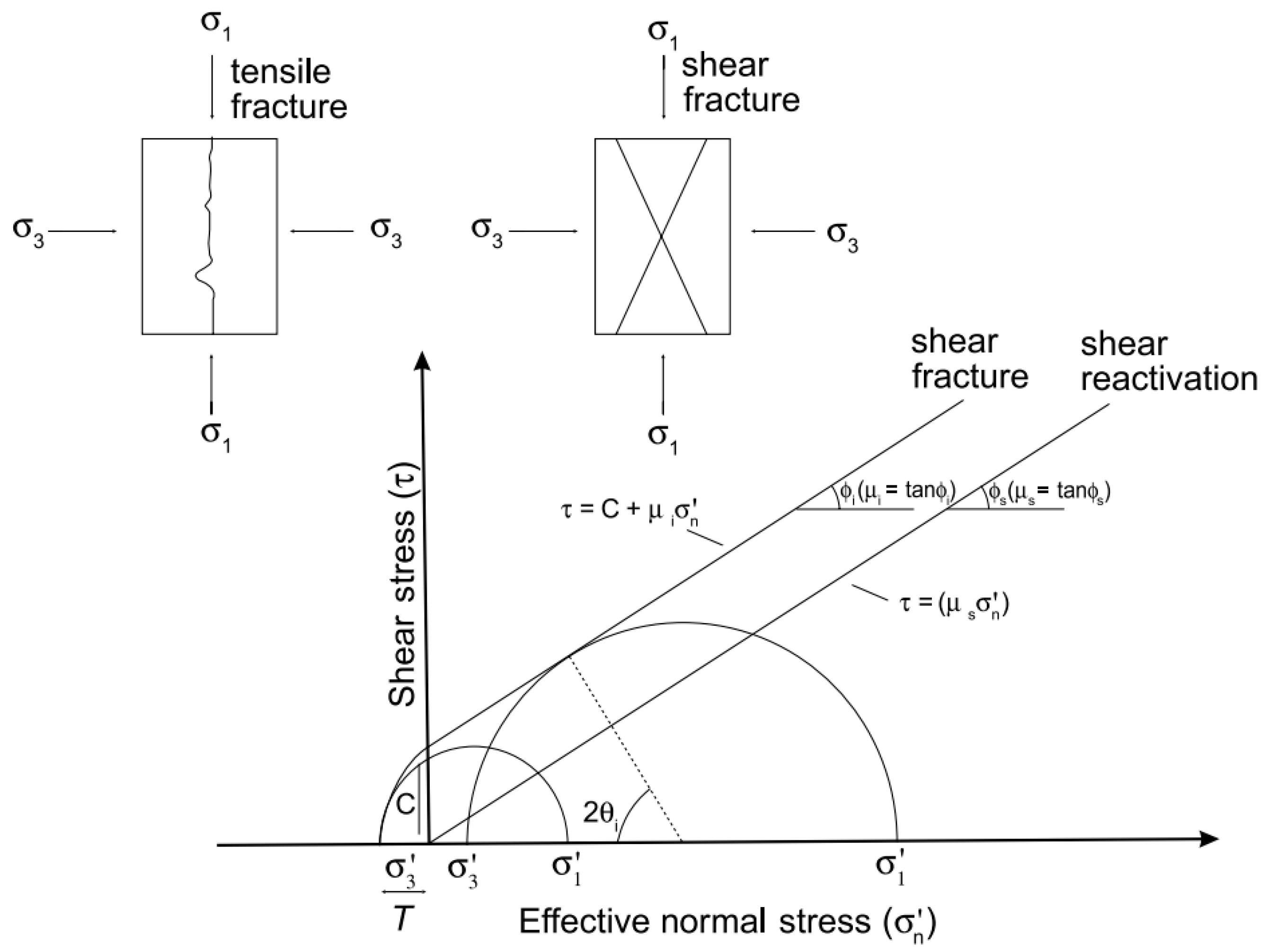
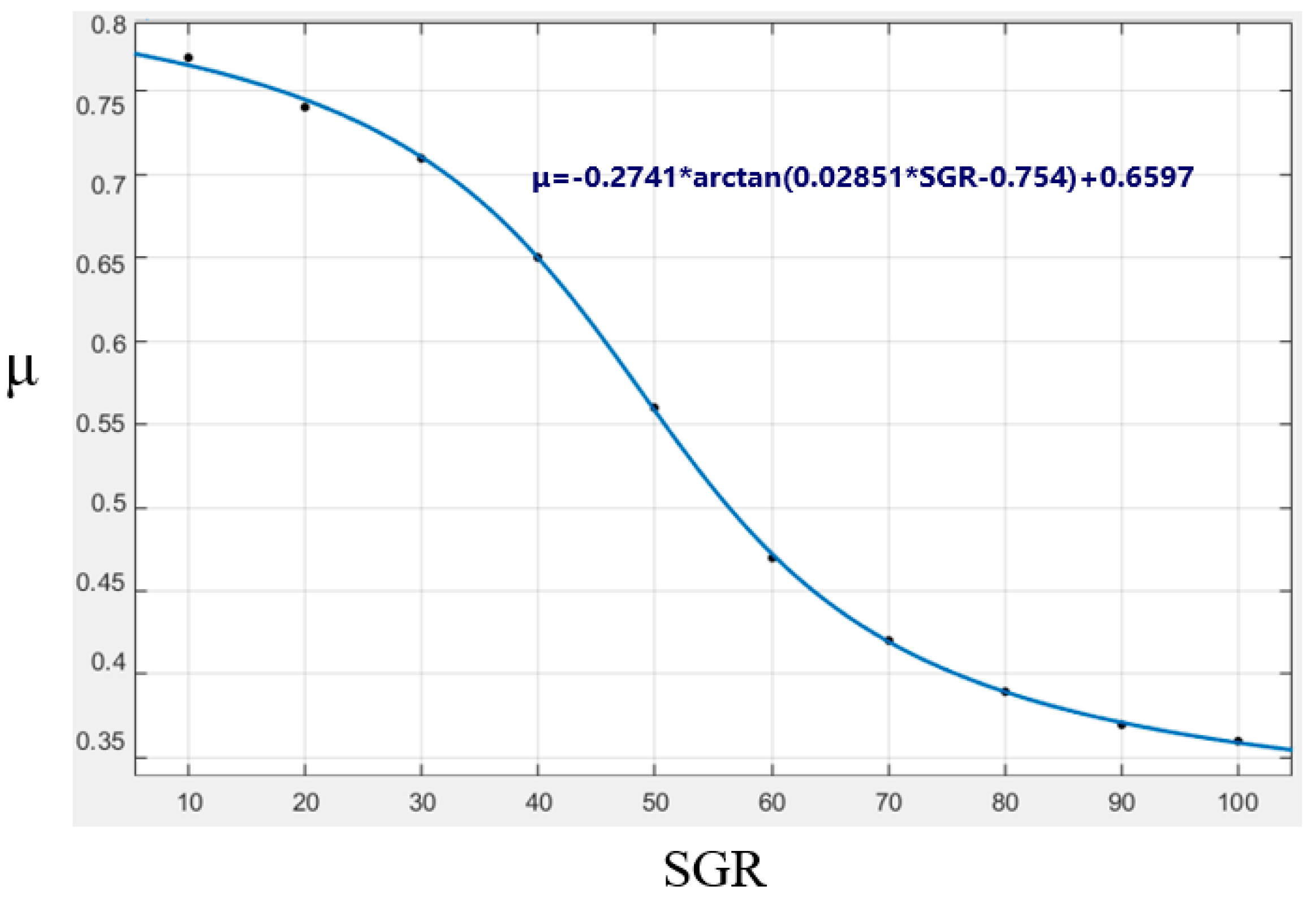
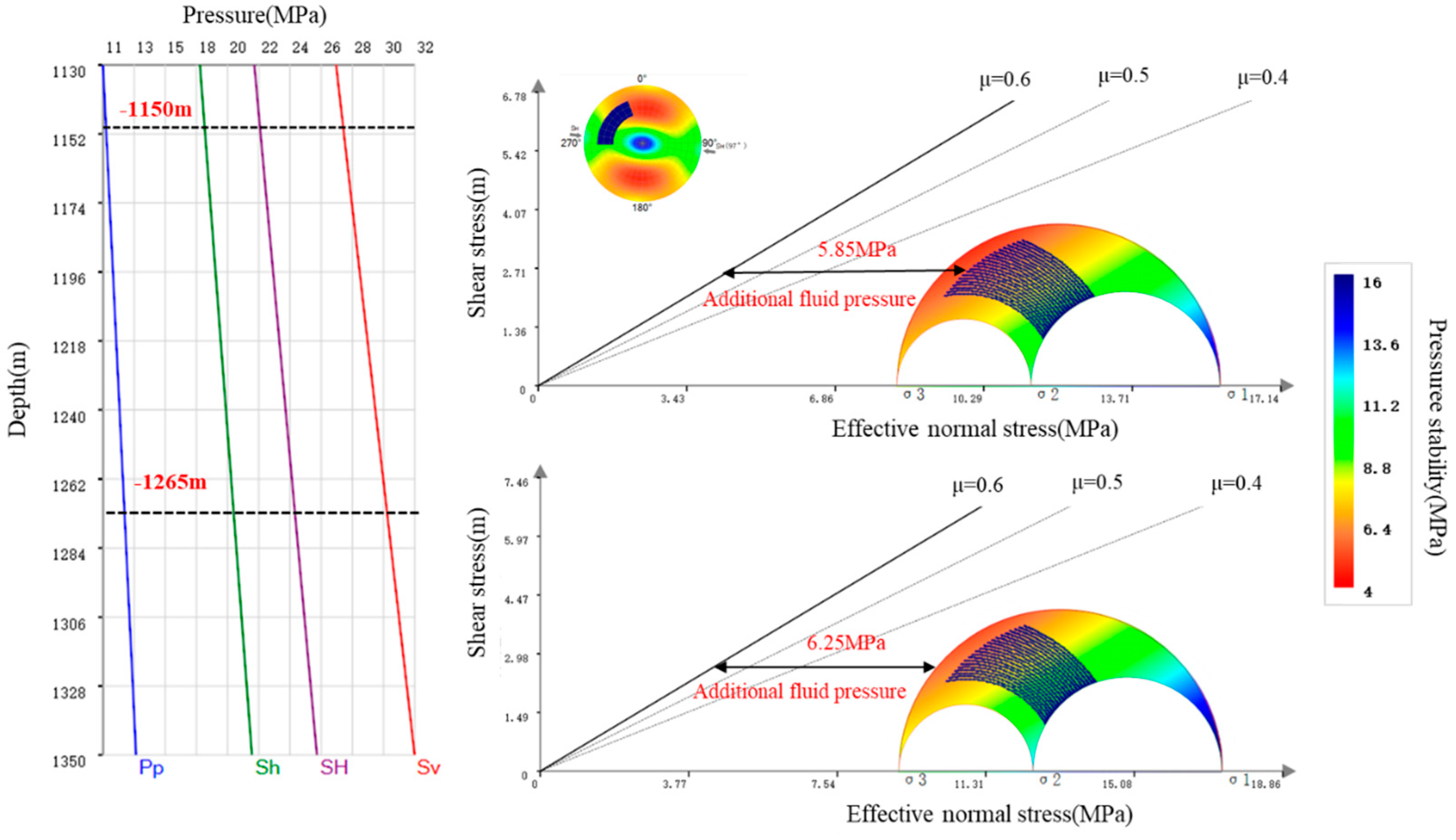
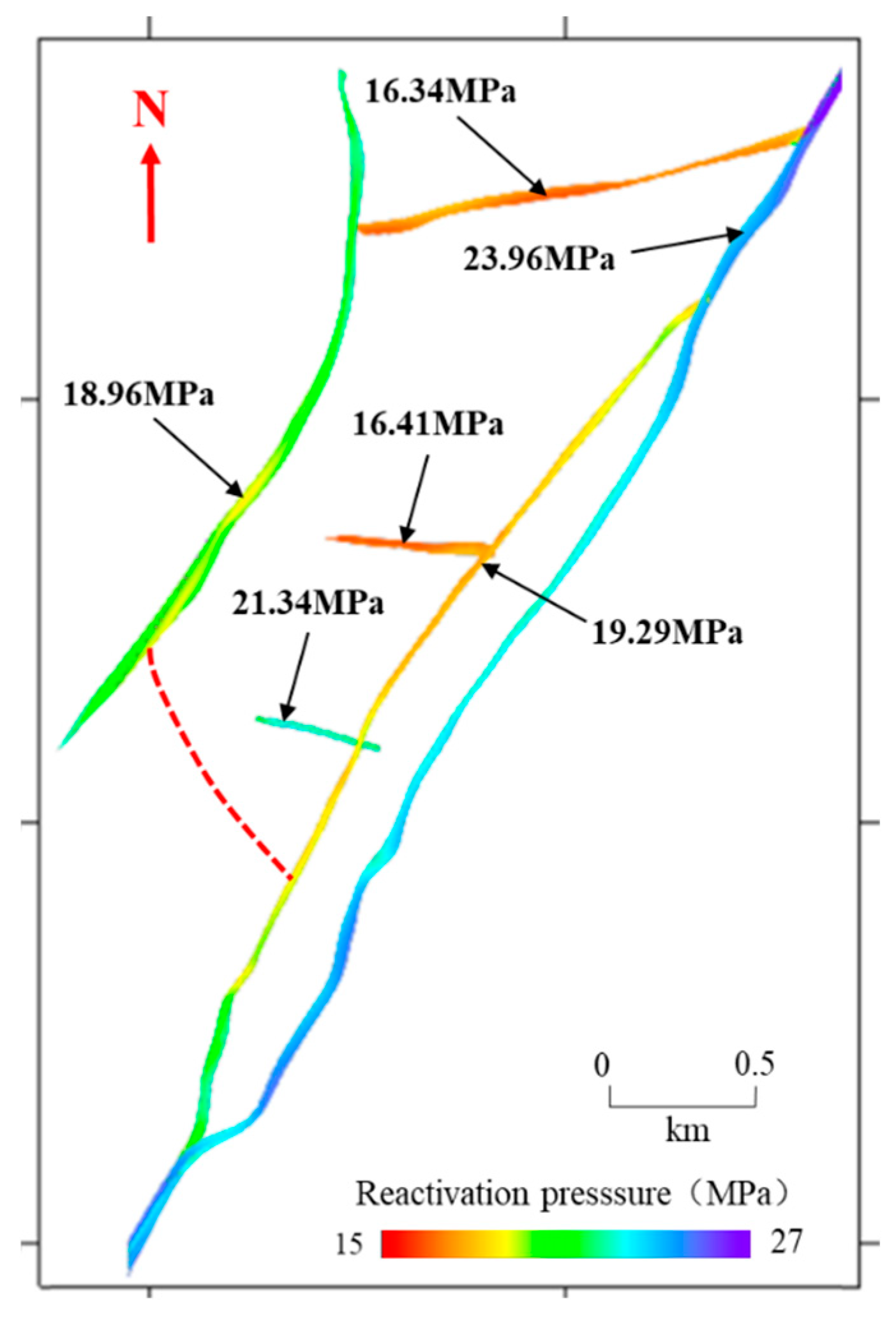
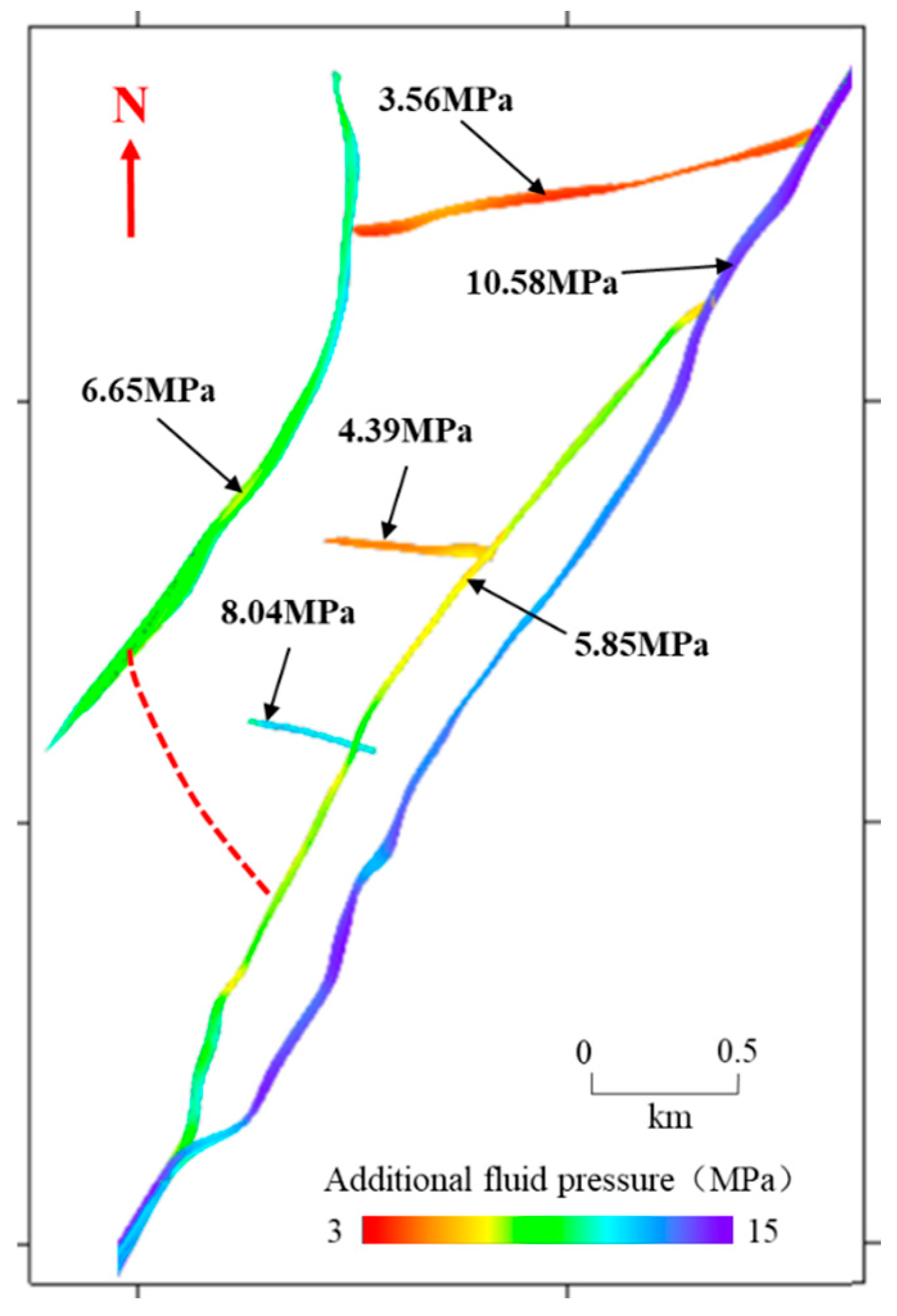
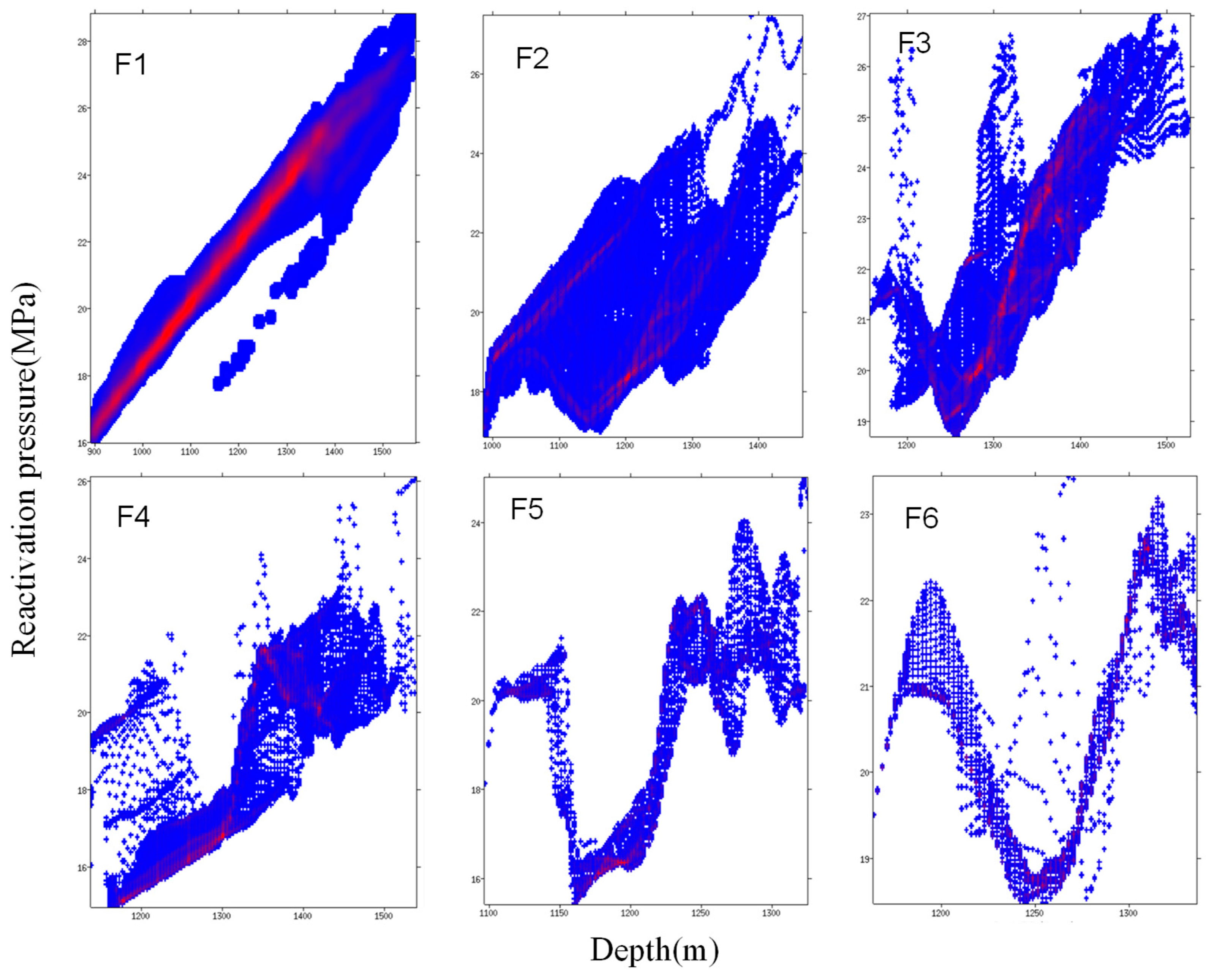
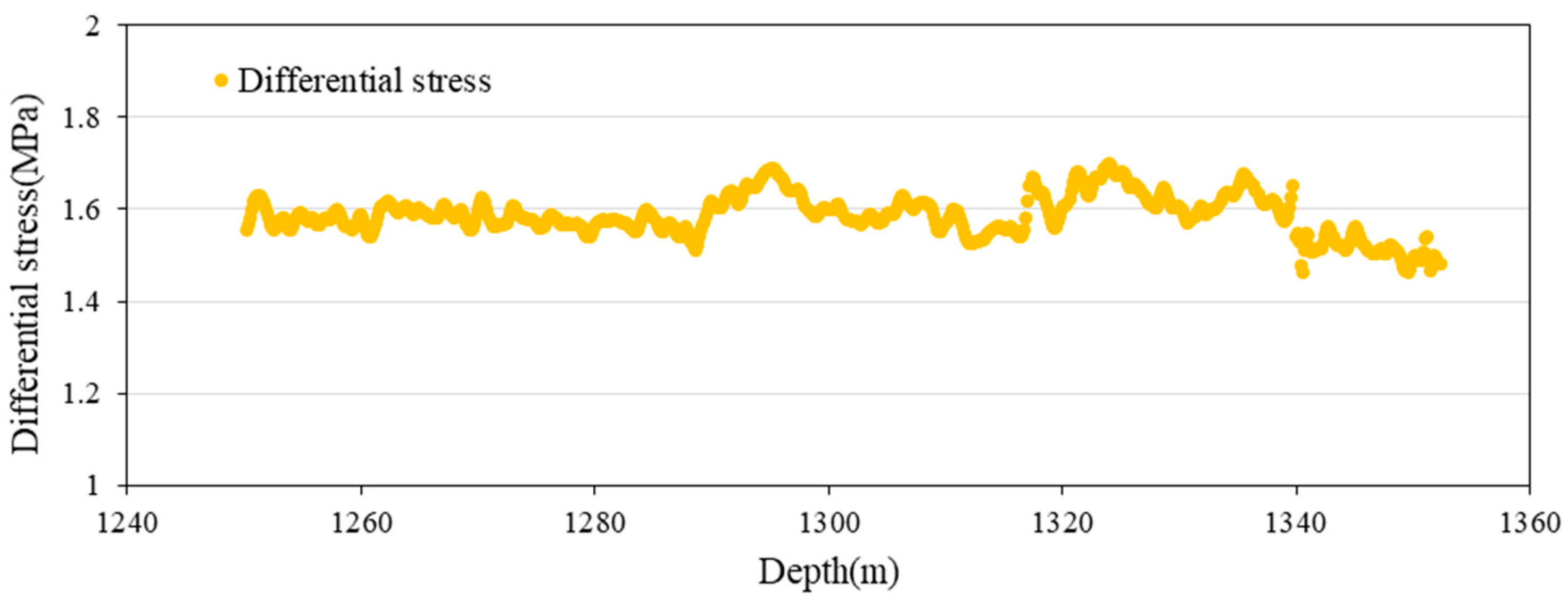
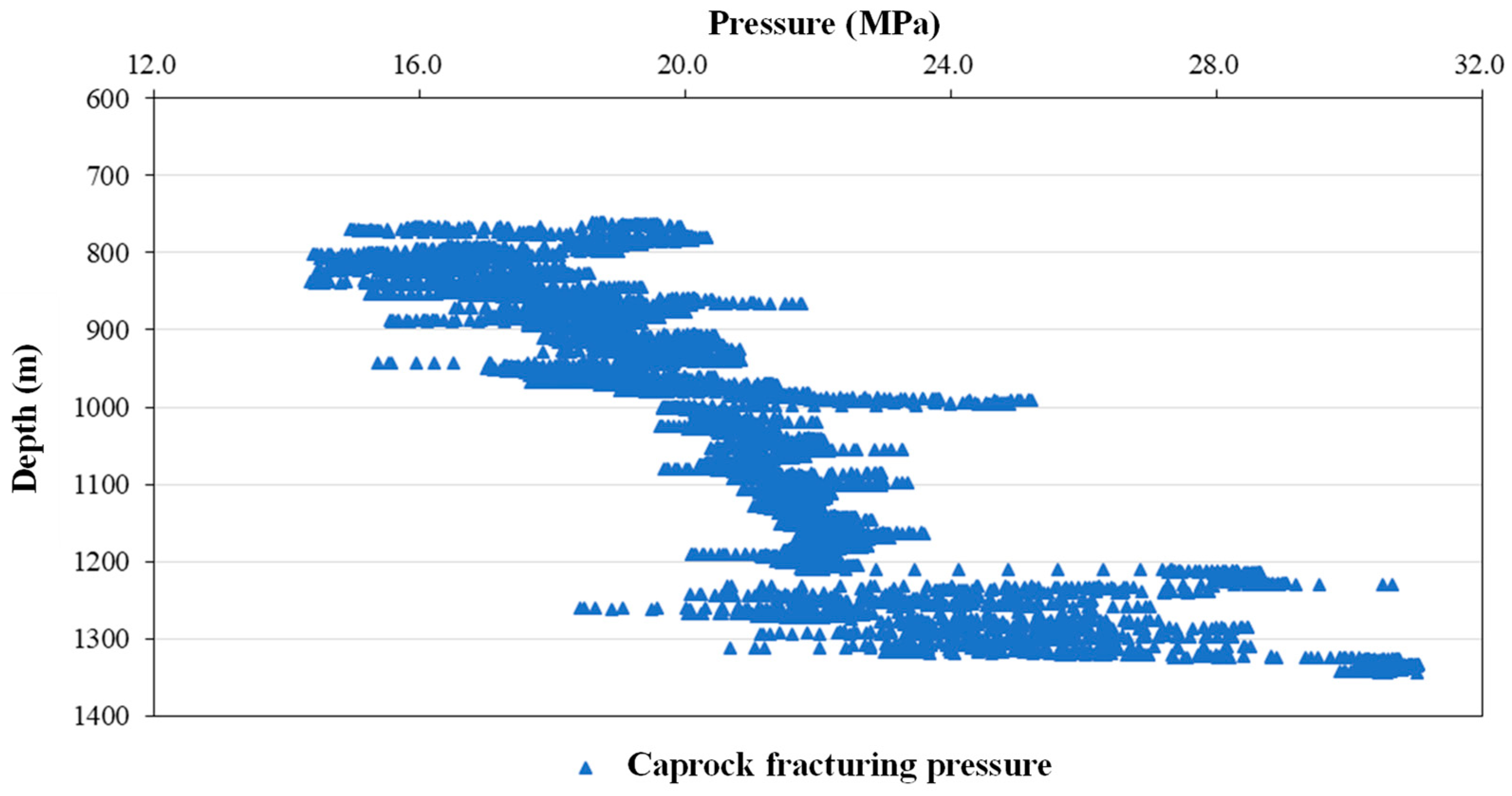
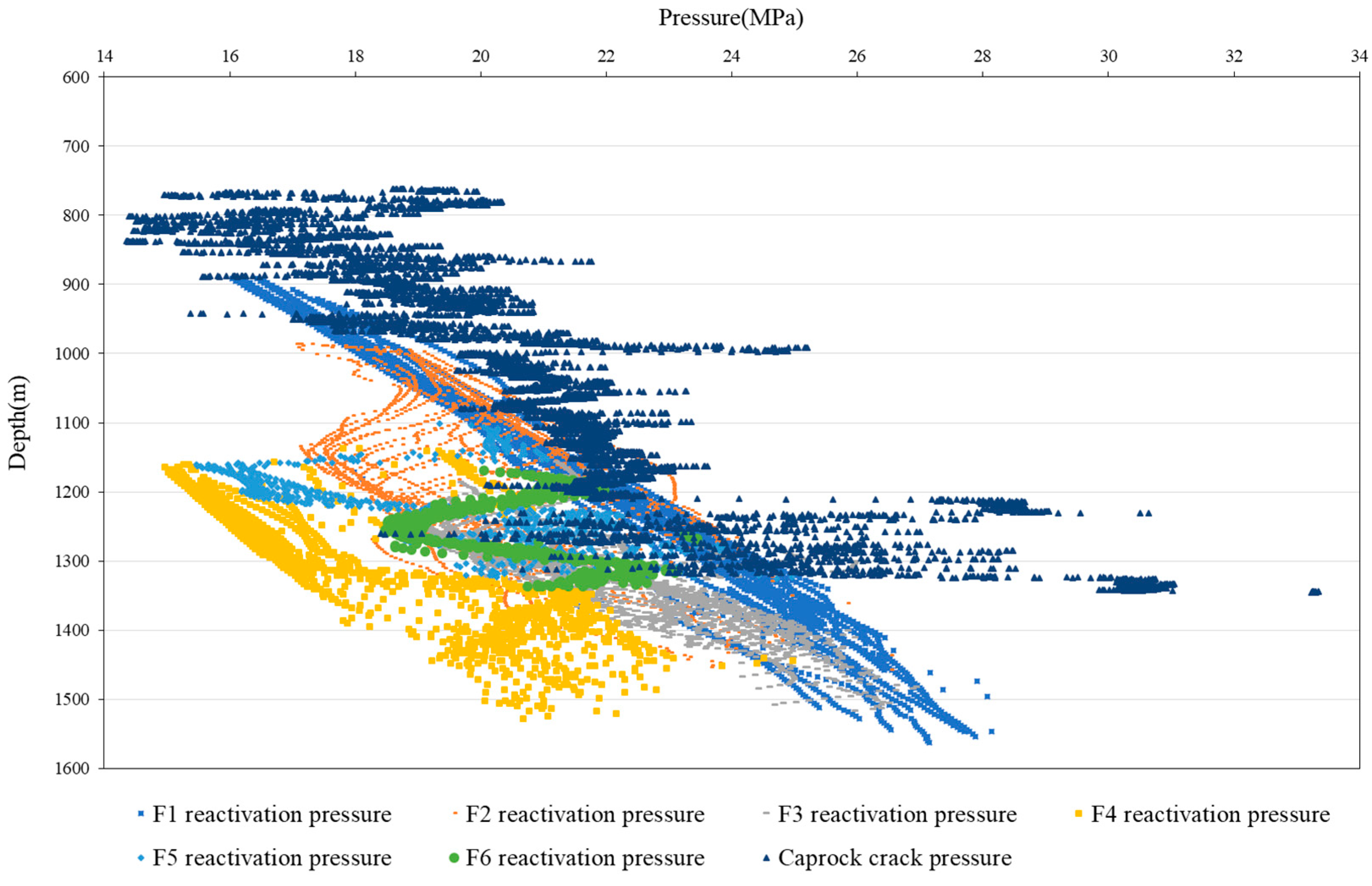
| Fault | F1 | F2 | F3 | F4 | F5 | F6 |
|---|---|---|---|---|---|---|
| Depth (m) | 1524–2100 | 1160–1280 | 1285–1585 | 1440–1600 | 1185–1240 | 1210–1445 |
| Dip (°) | 65.1 | 55.5 | 59.3 | 58.6 | 38.4 | 35.8 |
| Strike (°) | 212.5 | 213.3 | 31.7 | 79.3 | 277.4 | 287.5 |
| Sample No. | Well Depth /m | The Proportion of Different Types of Clay Minerals/% | Ratio of Imon Mixed Layer | |||
|---|---|---|---|---|---|---|
| Imon Mixed Layer | Illite | Kaolinite | Chlorite | |||
| 1 | 1341 | 42 | 29 | 15 | 14 | 73 |
| 2 | 1345 | 48 | 23 | 15 | 14 | 79 |
| 3 | 1347 | 57 | 23 | 10 | 10 | 71 |
| 4 | 1348 | 58 | 22 | 10 | 10 | 71 |
| 5 | 1349 | 62 | 23 | 8 | 7 | 76 |
| 6 | 1354 | 40 | 33 | 14 | 13 | 56 |
| 7 | 1355 | 75 | 15 | 5 | 5 | 86 |
| 8 | 1356 | 71 | 16 | 6 | 7 | 86 |
| 9 | 1358 | 65 | 21 | 7 | 7 | 88 |
| 10 | 1368 | 71 | 13 | 8 | 8 | 90 |
| 11 | 1371 | 82 | 7 | 6 | 5 | 96 |
| 12 | 1372 | 72 | 18 | 5 | 5 | 95 |
| 13 | 1381 | 77 | 10 | 7 | 6 | 94 |
| 14 | 1384 | 80 | 9 | 6 | 5 | 96 |
| 15 | 1391 | 61 | 23 | 8 | 8 | 68 |
| Fracture Mode | Rock Fracture Criterion | Stress Conditions |
|---|---|---|
| Tensile rupture (hydraulic rupture) | P = σ3 + T | (σ1 − σ3) < 4T |
| Mixed rupture of tension and shear | P = σn + (4T2 − τ2)/4T | 4T < (σ1 − σ3) < 6T |
| Shear fracture | P = σn + (C − τ)/μ | (σ1 − σ3) > 6T |
Disclaimer/Publisher’s Note: The statements, opinions and data contained in all publications are solely those of the individual author(s) and contributor(s) and not of MDPI and/or the editor(s). MDPI and/or the editor(s) disclaim responsibility for any injury to people or property resulting from any ideas, methods, instructions or products referred to in the content. |
© 2024 by the authors. Licensee MDPI, Basel, Switzerland. This article is an open access article distributed under the terms and conditions of the Creative Commons Attribution (CC BY) license (https://creativecommons.org/licenses/by/4.0/).
Share and Cite
Chen, X.; Zhang, T.; Wen, H.; Jin, Y.; Meng, L. Investigation of the Upper Safety Operating Pressure Limit for Underground Gas Storage Using the Fault Activation Pressure Evaluation Method. Processes 2024, 12, 1910. https://doi.org/10.3390/pr12091910
Chen X, Zhang T, Wen H, Jin Y, Meng L. Investigation of the Upper Safety Operating Pressure Limit for Underground Gas Storage Using the Fault Activation Pressure Evaluation Method. Processes. 2024; 12(9):1910. https://doi.org/10.3390/pr12091910
Chicago/Turabian StyleChen, Xianxue, Tianguang Zhang, Haibo Wen, Yejun Jin, and Lingdong Meng. 2024. "Investigation of the Upper Safety Operating Pressure Limit for Underground Gas Storage Using the Fault Activation Pressure Evaluation Method" Processes 12, no. 9: 1910. https://doi.org/10.3390/pr12091910





